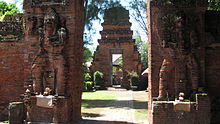Bali Kingdom
Kingdom of Bali
| |||||||||||||||
|---|---|---|---|---|---|---|---|---|---|---|---|---|---|---|---|
| 914–1908 | |||||||||||||||
| Anthem: ᬩᬮᬶ ᬤ᭄ᬯᬶᬧ ᬚᬬ! "Bali Dwipa Jaya!" ("Glorious Bali Island!") | |||||||||||||||
 The maximum extent of Balinese Kingdom of Gelgel in the mid-16th century. The territory covers Blambangan (Banyuwangi) to the western part of Sumbawa. | |||||||||||||||
| Status | Sovereign state (914-1343) vassal state of the Majapahit Empire (1343-1512) Nine Kingdoms period (1512-1908) | ||||||||||||||
| Capital |
| ||||||||||||||
| Common languages | Kawi and Sanskrit (religious)Regional
| ||||||||||||||
| Religion | State religion: Hinduism Minority: Mahāyāna Budhism | ||||||||||||||
| Demonym(s) | Balinese, Balinar | ||||||||||||||
| Government | Absolute monarchy | ||||||||||||||
| Raja, Arya, Maharaja, Dalem, Dewa Agung | |||||||||||||||
• c. 914 (first) | Śrī Kesarī Warmadewa | ||||||||||||||
• c. late 10th century | Udayana Warmadewa (Udayana the Great) | ||||||||||||||
• c. early 11th century | Anak Wungçu | ||||||||||||||
• c. 1180 | Jayapangus | ||||||||||||||
• c. 1343 | Aŕya Kénceng | ||||||||||||||
• c. 1520-1558 | Dalém Baturénggong | ||||||||||||||
• c. 1903-1908 (last) | Dewa Agung Jambé II | ||||||||||||||
| History | |||||||||||||||
• Klungkung | April 18, 1908 | ||||||||||||||
| Currency | Native silver coins and Chinese kepeng coins (pis bolong) | ||||||||||||||
| |||||||||||||||
| Today part of | Indonesia ∟ Bali ∟ East Java ∟ West Nusa Tenggara | ||||||||||||||
The Kingdomship of Bali (
Because of its proximity and close cultural relations with the neighbouring island of
Since the mid-19th century, the colonial state of the
History
Prehistory
Bali has been inhabited by humans since
Early kingdom

The historical period in Bali started in c. 8th century, marked by the discovery of inscribed Buddhist

In the early 10th century, a king called
It is not known precisely where the capital of the kingdom was during the 10th and 11th centuries, but the political, religious, and cultural centre of the kingdom may have been in the present-day
Javanese ties

In the second half of the 10th century, Bali was ruled by King
The rock-cut candi shrine of Gunung Kawi in Tampaksiring was made around the same period. It demonstrates a similar temple style of Java during the late Mataram period. The Warmadewa dynasty continued to rule Bali well until the 12th century with the reigns of Jayasakti (1146–50) and Jayapangus (1178–81). Contacts with imperial China were also important during this period. Chinese coins called kepeng were widely in use in the Balinese economy. In the 12th century, King Jayapangus of northern Bali is known to have married a Chinese princess and has been immortalised through the Barong Landung art form as the effigy of the king and his Chinese consort.
After the Warmadewa dynasty, their descendant, and their link to the Javanese court, there is no continuous further detailed information found about the rulers of Bali. It seems that Bali had developed a new native dynasty quite independent from Java.
In the late 13th century, Bali once again appeared in Javanese sources. In 1284, the Javanese king
The Javanese contacts led to a deep impact on the language of Bali which was impacted by the
Majapahit period

| History of Indonesia | |
|---|---|
 | |
| Timeline | |
| 600s–900s | |
| Mataram Kingdom | 716–1016 |
| Bali Kingdom | 914–1908 |
| Sunda Kingdom | 932–1579 |
| Kahuripan Kingdom | 1019–1045 |
| Kediri Kingdom | 1045–1221 |
| Dharmasraya Kingdom | 1183–1347 |
| Pannai Kingdom | 1000s–1300s |
| Singhasari Empire | 1222–1292 |
| Majapahit Empire | 1293–1527 |



